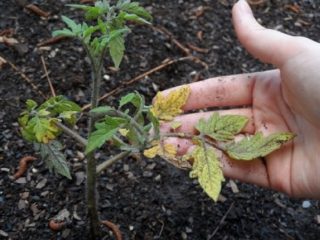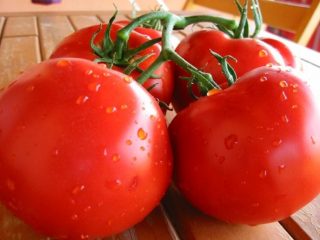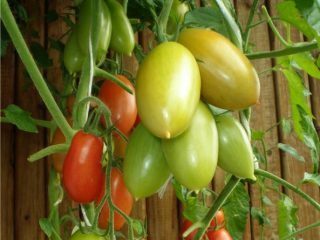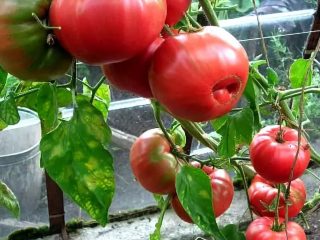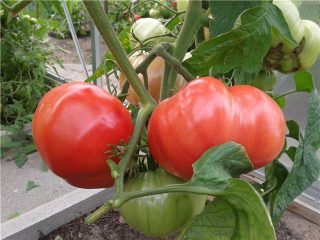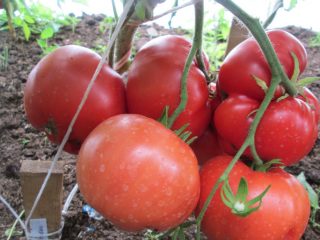Content
Tomato Cascade is a selection, indeterminate variety of medium-early ripening. Forms smooth fruits, which are consumed fresh and used for winter harvesting. The crop is adapted to temperate climate conditions; it is grown both in open areas and in greenhouse structures.
History of selection
Tomato Cascade was created on the basis of the Agros company in Novosibirsk. The originator of the variety is a group of scientists led by V. G. Kachainik. After experimental cultivation and confirmation of the declared characteristics, in 2010 the variety was entered into the State Register. Recommended for cultivation in all regions. In the Urals and Siberia, tomatoes are grown in greenhouses. In the Central zone, the fruits have time to ripen in an open area.
Description of the tomato variety Cascade
The Cascade tomato is a varietal representative, and not a hybrid form, so it produces complete planting material and calmly reacts to changes in night and day temperatures.This is an indeterminate plant (without limiting the end point of growth). When the height of the stems reaches 150-180 cm, the top of the tomato is broken off. Form a bush with one or two stems.
Medium early variety. The fruits begin to ripen two months after the seedlings are planted in the ground. The tomatoes do not ripen simultaneously, but over a long period of time. The fruits of the first cluster are harvested in August, the last bunch ripens in October, therefore, in regions with short summers, a greenhouse is recommended so that the ovaries are not damaged by frost.
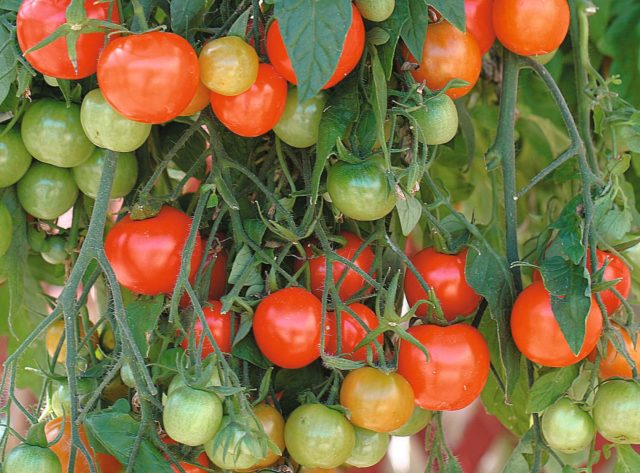
The crop received its varietal name for the branched structure of the fruit clusters.
Characteristics of the Cascade tomato (pictured):
- The stem is thick, the fiber structure is rigid, woody at the base. The surface is slightly ribbed, finely pubescent, brown in color with a green tint.
- The leaves are few, medium in size, lanceolate in shape, arranged alternately. The leaf blade is slightly corrugated with wavy edges, attached to long thick petioles, light green.
- Fruit clusters are complex, highly branched. The length of the first bunch can reach 30 cm, the subsequent ones are shorter. All have the same density. There are 5-6 fruit clusters on the stem, the first one is formed after the fourth leaf.
- The Cascade variety blooms abundantly, the plant is self-pollinating, the flowers do not fall off, each one produces an ovary.
- The root system is powerful, superficial, compact, grows to 35-40 cm. The culture does not take up much space. You can place 4-5 tomatoes per 1 m2.
Description of fruits
Cascade tomatoes are small in size. They all have the same shape. The fruits of the first cluster do not differ in size from the last tomatoes:
- diameter within 8-10 cm, weight – 100-120 g;
- the shape is round, cylindrical, the surface is flat, smooth, with a glossy sheen;
- the peel is elastic, thin, bright red. The variety is prone to cracking when there is a lack of moisture;
- the pulp is juicy, dense in consistency, without voids;
- There are four seed chambers. The seeds are light yellow or beige, flat.
On a five-point tasting scale, the Cascade tomato received 4.8 points. The taste is sweet and sour, balanced, the tomatoes have a distinct nightshade smell.
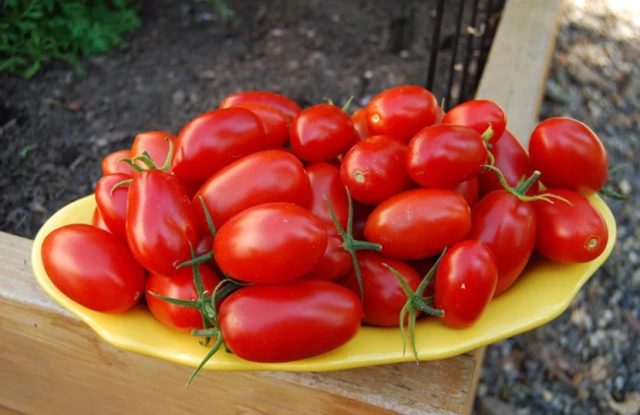
Fruits of the Cascade variety, collected at the stage of milky ripeness, ripen safely in room conditions
Characteristics of the Cascade tomato
According to the characteristics given by the copyright holder, the Cascade tomato is a stress-resistant plant with good immunity to infections and pests. The variety is productive due to self-pollination, the length of the brushes and their density, and a long fruiting period.
Productivity of Cascade tomato and what affects it
On average, 20-25 fruits weighing 100 g are formed on a cluster. The average yield of a bush with 5-6 clusters is 8-10 kg. When grown in a greenhouse, 3 plants are placed per 1 m2, i.e. the figure is in the range of 24-30 kg. In an open area, the height of the plant does not exceed 150 cm, 4-5 clusters are formed on the crop, i.e. the yield will be lower.
When grown indoors, the variety bears fruit consistently. To achieve good performance, the plant is watered, fed, and fruit-bearing brushes, shoots and leaves are removed from the lower part of the stem. In addition to the listed measures, in an unprotected area for tomatoes, good lighting is necessary, as well as compliance with crop rotation. Tomatoes have not been planted in the same bed for more than three years.
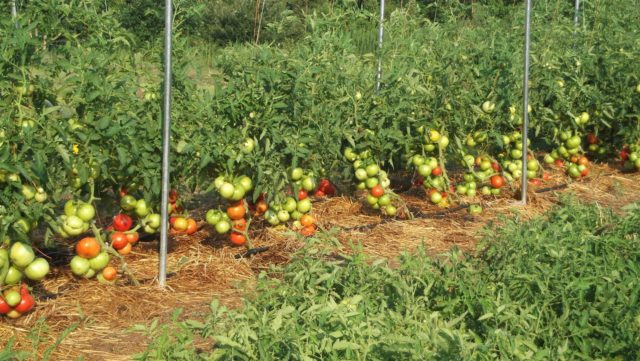
Yields are affected by prolonged precipitation; the rate decreases due to soil waterlogging and ultraviolet deficiency.
Resistance to diseases and pests
The Cascade variety has good resistance to diseases and pests. The development of fungal infection is affected by high humidity in the greenhouse and excessive watering. Tomato does not respond well to stagnant water. In an open area, proximity to weeds and nightshade crops, which have the same diseases and pests, is unacceptable. The main problems that arise during cultivation:
- late blight;
- tobacco mosaic;
- blackleg.
If aphids and spider mites are widespread in the area, the pests can also spread to tomatoes.
Area of application of fruits
Cascade is a salad variety, it is mainly consumed fresh, made into juice or ketchup. Included in vegetable salads. The small size of the fruits and their uniform shape make it possible to prepare them in their entirety for the winter. Tomatoes are pickled and salted.
The peel is thin, but elastic, tolerates heat well, and does not crack. Tomatoes have a long shelf life and do not lose their marketable appearance within 15 days, which allows the variety to be grown for commercial purposes. Cascade tomatoes react calmly to transportation.
Advantages and disadvantages
The Cascade variety is one of the productive indeterminate tomatoes, popular among vegetable growers for a number of advantages over other varieties:
- complete planting material;
- high productivity;
- long fruiting;
- stable immunity;
- high gastronomic assessment;
- evened fruit shape;
- universal use of tomatoes;
- long shelf life;
- compact root system, allowing you to plant more plants in a small area;
- the plant is open, the crown is not dense, so it takes little time to remove the leaves;
- due to the long, branched, dense brushes the plant has a decorative appearance;
- Possibility of growing using open and closed methods;
- Suitable for cultivation in all regions.
The Cascade tomato has no particular disadvantages, if you do not take into account cracking of the fruit. But this is more likely not a disadvantage of the variety, but rather incorrect agricultural technology.
Features of planting and care
Tomato variety Cascade is propagated by independently collected or purchased seeds (seedling method).
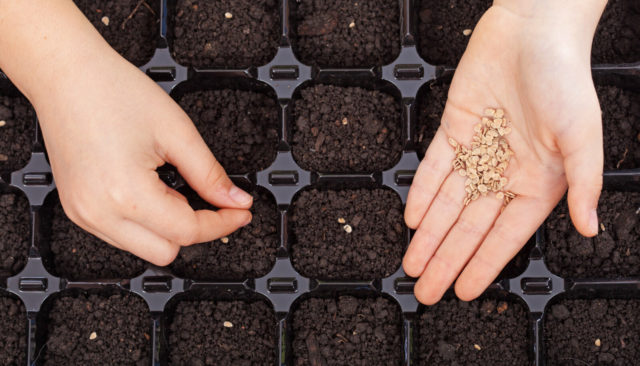
To obtain planting material, seeds are planted in March.
After 2 months, the tomato is planted on the plot, while making sure that the seedlings are not too elongated.
Sequence of work:
- Containers for seedlings are filled with fertile substrate consisting of peat and compost.
- The seeds are pre-disinfected in a manganese solution and treated with a growth-stimulating drug.
- Make furrows 2 cm deep, maintaining an interval of 5 cm. Seeds are planted at a distance of 1 cm.
- Cover with soil and cover the container with transparent film.
- They are placed in a room with a temperature of +20-22 0C, providing fourteen-hour lighting.
- Periodically moisten the soil.
After the sprouts appear, the film is removed. Tomatoes are fed with a nitrogen-containing product. Water as the top layer of soil dries.
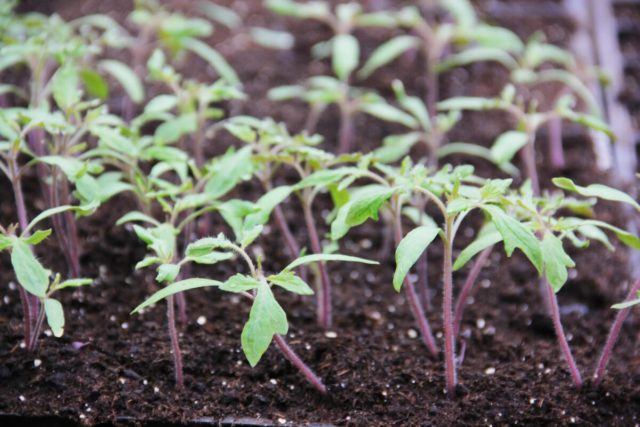
When three full leaves are formed, the Cascade tomato is dived into separate containers
After the soil warms up to +17 0C and the threat of return frosts has passed, the planting material is placed in an open area.The timing will be different for each region, but usually the work is carried out in May. Seedlings are placed in the greenhouse at the end of April or in the first ten days of May.
Tomato planting algorithm:
- Compost is laid out on the garden bed, dug up, and nitrophoska is added.
- Make holes at a distance of 50 cm, put peat and ash on the bottom.
- The tomato is placed at right angles to the ground and covered with soil up to the lower leaves.
- Fix the support. As the tomato grows, tie it up.
The planting is watered abundantly.
Agricultural technology of the Cascade variety:
- removing weeds, loosening the soil;
- fertilizing every 20 days. Alternate phosphorus, organic matter, potassium, superphosphate;
- watering at the root. In a greenhouse, the procedure is carried out every other day; in open ground, they are guided by precipitation; it is necessary that the soil is always moist;
- eliminating stepsons and brushes, trimming lower leaves.
Pest and disease control methods
For preventive purposes, tomatoes are treated with copper sulfate during fruit set. After 3 weeks, the procedure is repeated. If signs of infection appear, the affected parts are cut off and the bushes are sprayed with Fitosporin or Bordeaux mixture. They get rid of aphids with “Aktara” and remove anthills from the area. In the fight against spider mites, Actellik is used.
Conclusion
Tomato Cascade is a high-yielding, indeterminate variety of mid-early ripening. Suitable for growing in greenhouses and open beds. Recommended for cultivation in all regions with temperate climates. The fruits are characterized by high nutritional value and are universal in use. Due to their good transportability and long shelf life, tomatoes are grown commercially.
Reviews of tomato Cascade


